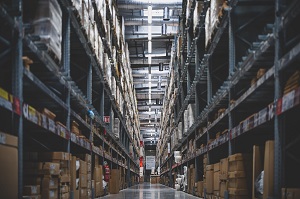![]() Distribution Issues is a news and information topic monitored and covered by: Prepper Watch – Food Concerns
Distribution Issues is a news and information topic monitored and covered by: Prepper Watch – Food Concerns
Introduction
In the modern world, distribution networks play a pivotal role in the efficiency of supply chains, especially for essential goods like food. However, in times of crisis—whether due to natural disasters, economic collapse, or a significant disruption caused by geopolitical events—these networks can fail, leading to food delivery delays and increased waste.
For preppers, this situation represents a critical vulnerability that requires strategic planning, foresight, and preparation. Here’s how a prepper can prepare for distribution issues, focusing on the food supply, to mitigate the risks associated with food delivery breakdowns.
Understanding Distribution Issues and Their Impacts
Before diving into how to prepare, it is crucial to understand the specific nature of distribution issues and how they affect the food supply.
What Are Distribution Issues?
Distribution issues refer to any disruption in the process of getting goods from their point of production to their point of sale or consumption. These disruptions can occur at any level of the distribution chain, from manufacturers and wholesalers to retailers and local food banks.
Key causes of distribution issues include:
- Natural disasters: Hurricanes, floods, wildfires, and earthquakes can destroy infrastructure like roads, bridges, warehouses, and transportation hubs.
- Political instability: Civil unrest, wars, and strikes can cause major disruptions in both domestic and international supply chains.
- Economic crises: Inflation, currency devaluation, or even a recession can disrupt the flow of goods, including food.
- Technological failure: Cyberattacks or system failures in distribution networks can cause data errors or prevent goods from being efficiently tracked or delivered.
Impacts of Distribution Issues
- Delayed Food Delivery: When distribution networks break down, food may not reach stores or homes on time. This can lead to a lack of stock on shelves and an inability to get food when it’s most needed.
- Increased Waste: Without timely delivery, perishable foods such as fruits, vegetables, dairy, and meats can spoil, creating waste. This waste can exacerbate food shortages and increase the risk of malnutrition.
Strategic Stockpiling and Long-Term Food Storage
The first step in preparing for distribution issues is to stockpile food. However, stockpiling isn’t just about hoarding large quantities of food—it’s about smart preparation and ensuring that your food storage is practical, durable, and sustainable.
Choosing the Right Foods for Storage
When choosing what to stockpile, consider the following:
- Long shelf-life foods: Canned goods, dried beans, rice, pasta, grains, freeze-dried foods, and powdered milk can last for years when stored correctly.
- Freeze-dried meals: These are lightweight, nutritious, and can be prepared quickly with just hot water. They’re ideal for long-term storage.
- Survival rations: Military-grade MREs (Meals Ready-to-Eat) are designed to withstand extreme conditions and provide essential nutrients over extended periods.
- Dehydrated foods: Like freeze-dried meals, dehydrated foods are also lightweight and easy to store for long periods. They include vegetables, fruits, and meats.
- Water: Don’t forget to stockpile water. In the event of distribution issues, access to clean water may also be disrupted. Aim for at least one gallon of water per person per day for a minimum of 30 days.
Storing Food Properly
Proper food storage is essential for ensuring that your supplies remain intact and usable. Here’s how you can optimize your storage methods:
- Cool, dry, and dark places: Store food in a climate-controlled environment. Excess heat, humidity, and light can degrade food quality, so aim for temperatures between 50-70°F.
- Vacuum sealing: This method removes air from bags or containers, reducing the risk of spoilage. It’s ideal for foods like dried beans, rice, and grains.
- Mylar bags with oxygen absorbers: Mylar bags provide an airtight seal, protecting food from pests and spoilage. Using oxygen absorbers further ensures long-term storage by reducing oxidation.
- Can rotation: Even canned goods have an expiration date, so practice the “first in, first out” (FIFO) method. Use older items first and replace them with newer ones.
Emergency Food Kits
Consider putting together a bug-out bag (BOB) or an emergency food kit that includes at least three days’ worth of meals for each member of your household. These kits should contain easily prepared, non-perishable items like energy bars, canned foods, and bottled water.
Growing Your Own Food
While stockpiling is essential, it’s also wise to take steps to ensure a continuous food supply that is less reliant on external distribution networks. Growing your own food, especially in a crisis, provides a reliable source of nutrition.
Establishing a Garden
A garden can be your first line of defense in a situation where food supply chains break down. Choose crops that are easy to grow, such as:
- Root vegetables: Potatoes, carrots, and beets are relatively simple to grow and have long shelf lives when stored properly.
- Leafy greens: Kale, spinach, and lettuce are quick-growing and can provide fresh, healthy meals.
- Herbs: Basil, oregano, thyme, and rosemary can add flavor to meals and even have medicinal properties.
Hydroponics and Aquaponics
In situations where soil is unavailable or limited, hydroponics (growing plants in water with added nutrients) and aquaponics (a system that combines fish farming with hydroponics) can be excellent alternatives. These systems can be set up in smaller spaces and provide year-round harvests, making them ideal for urban environments or areas with poor soil.
Preserving the Harvest
Canning, drying, freezing, and fermenting are all methods of preserving your garden’s bounty for long-term storage. By preserving food from your own garden, you reduce your dependence on external food sources and increase your food security.
Diversifying Your Food Sources
In addition to growing your own food and stockpiling non-perishables, diversifying your sources of food can provide a more reliable and sustainable food supply.
Foraging for Wild Foods
Many areas have a wealth of wild edibles, such as mushrooms, berries, nuts, and roots. Learning to identify edible plants in your region and how to properly harvest them can be a lifesaver when distribution issues occur.
Hunting and Fishing
For those in rural areas, hunting and fishing can provide a regular source of food. Be sure to acquire the necessary skills and knowledge to hunt local wildlife or fish for sustainable populations. Additionally, it may be beneficial to have tools like snares, fishing rods, and traps ready for use.
Livestock and Poultry
Raising animals for meat, eggs, and milk can also help alleviate food shortages during disruptions. Chickens, goats, rabbits, and even cows are all viable options, depending on the space you have and the resources available.
Alternative Food Preservation Techniques
When traditional refrigeration and distribution channels fail, alternative food preservation techniques can help prevent waste and preserve food for longer periods.
Canning
Canning is an excellent way to store fruits, vegetables, meats, and other perishables for long periods. Pressure canning and water-bath canning are both popular methods, with pressure canning being ideal for low-acid foods like meats and vegetables.
Fermentation
Fermented foods such as sauerkraut, kimchi, and pickles provide both nutrition and probiotic benefits. Fermentation is a relatively simple process and can be done with minimal resources.
Dehydrating and Freeze-Drying
Dehydrating removes the moisture from foods, which prevents the growth of bacteria and molds. Freeze-dried foods can last for years with proper storage and are particularly useful for prepping.
Establishing Local Networks
Finally, establishing local prepper communities or mutual assistance groups (MAGs) can help ensure that, even if individual food supplies run low, resources can be shared among groups. These networks are designed to help members in times of crisis, ensuring that everyone has access to food, water, and other necessary supplies.
Bartering and Trading
As distribution issues can lead to scarcity, bartering becomes an effective way to obtain goods. Being able to trade surplus food or other resources can be an essential tool for surviving when distribution networks are broken.
Local Food Sharing
If local stores run out of stock, it’s important to know which local farms, grocery stores, and farmers’ markets can serve as alternative sources. Forming relationships with local food producers will increase your chances of acquiring food directly from them during a supply chain breakdown.
Conclusion: Long-Term Resilience
Preparing for distribution issues involves a combination of strategic food stockpiling, growing your own food, diversifying food sources, and establishing alternative preservation techniques.
By taking proactive measures, preppers can reduce their reliance on external food sources, mitigate waste, and ensure their ability to thrive during periods of food insecurity. In an increasingly unpredictable world, resilience is key, and preppers who plan ahead will be better equipped to handle distribution disruptions when they occur.

